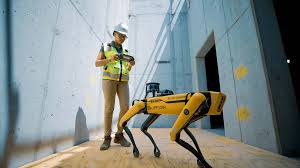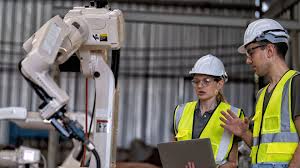
Contractor confidence in robotics technology has reached record highs, but actual adoption on jobsites is slipping, according to new industry research.
BuiltWorlds’ latest Equipment & Robotics Benchmarking Report reveals that positive evaluations of construction robotics jumped from 74% in 2024 to over 95% in 2025, with zero firms rating the technology as “poor” this year.

“This signals increased support for automation and intelligent equipment workflows,” said Audrey Lynch, senior research analyst for BuiltWorlds, in a news release.
However, the enthusiasm hasn’t yet translated into widespread deployment. Only 46% of firms reported actively using robotics on projects in 2025, a steep drop from 65% last year. Lynch explained that the shift is due to a move away from widespread pilot programs toward more selective but committed use cases.
“A large selection of last year’s reported robotics use came in the form of pilots,” Lynch said. “This year we’ve seen a much smaller share of pilots but more repeated use on projects, suggesting more selective though serious implementation, albeit on smaller scales.”
The findings highlight a key moment in the slow but steady march toward construction tech adoption. While contractors are no longer dismissing robotics outright, they are also avoiding large-scale, unproven rollouts.
Instead, firms are targeting proven, commercial-ready solutions rather than investing in early-stage startup prototypes. Established builders such as Suffolk, DPR, Webcor, and Turner Construction have been focusing resources on vetted tools like Canvas’ drywall finishing robot and Dusty Robotics’ layout solutions.
This strategic approach aligns with a broader industry push for ROI-driven adoption. Robotics is increasingly being integrated into specific, high-impact workflows such as layout marking, drilling, material transport, and repetitive finishing tasks.

Several factors contribute to the slowdown in adoption despite surging optimism:
“Contractors, owners and tech providers alike are exploring how robotics for tasks like layout, drilling or material transport, when combined with connected equipment and data-driven decision-making, can create a more efficient, responsive and scalable construction environment,” Lynch said. “This shift reflects a broader industry movement toward intelligent, tech-enabled workflows that bridge field execution with digital planning and performance optimization.”
While robotics usage is contracting in breadth, depth of use is growing. Firms that adopt robotics are doing so with an eye toward long-term integration rather than one-off experimentation.
Market analysts predict that if construction demand stays strong and hardware costs continue to fall, robotics could shift from niche tools to mainstream assets within five years.
The current dynamic—record optimism paired with selective adoption—suggests the industry is moving toward a “quality over quantity” phase, laying the groundwork for broader, more sustainable implementation in the next wave of construction innovation.
Originally reported by Sebastian Obando in Construction Dive.